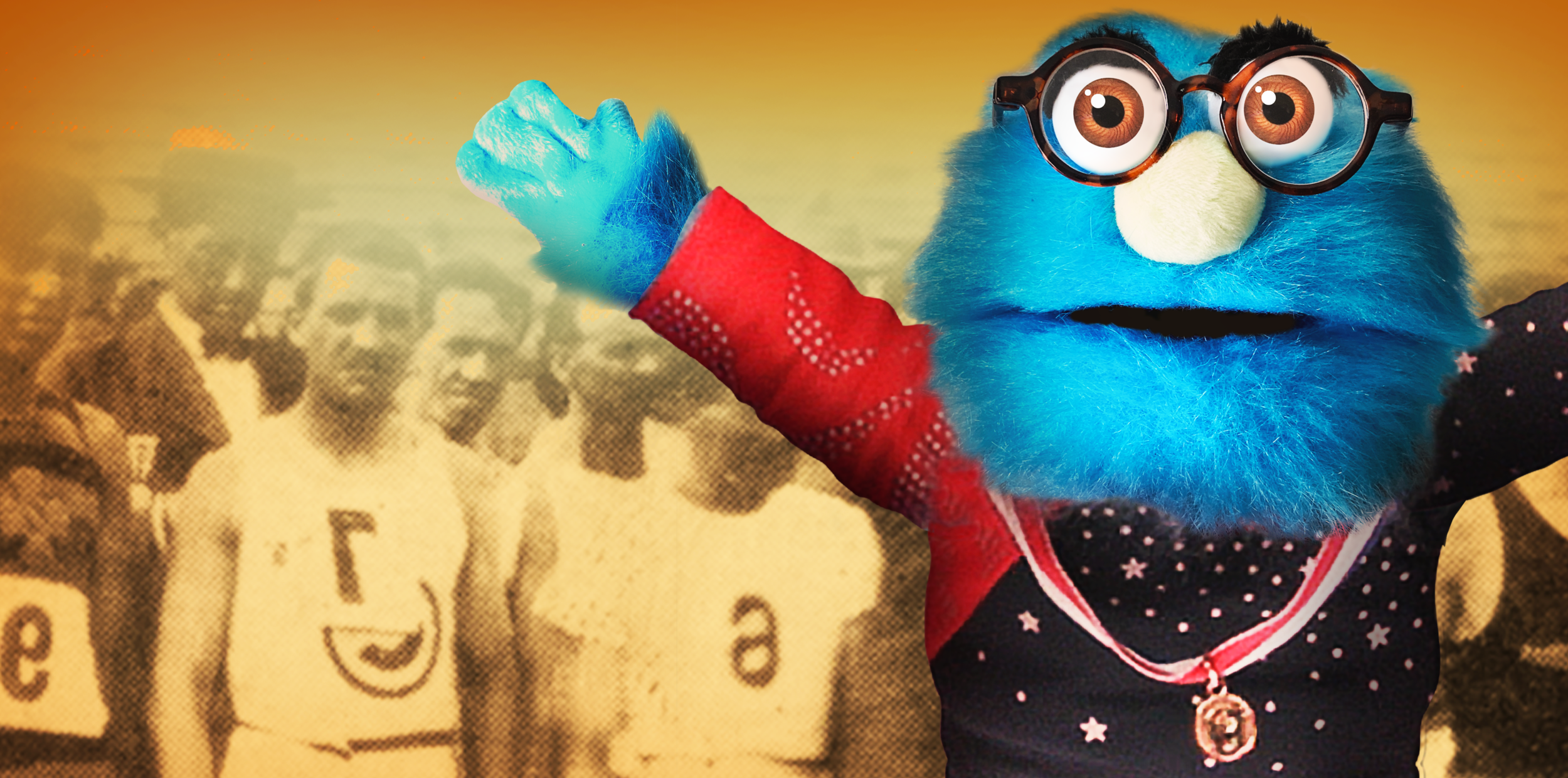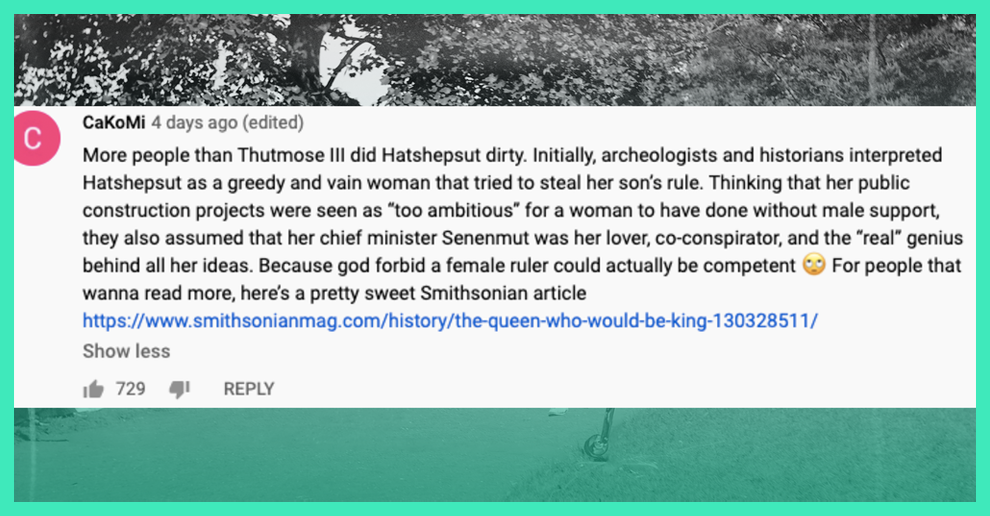
Lesson 4 - The Disastrous 1904 Olympic Marathon
Hello! And welcome to week 4 of Puppet University, online edition. I’m your TA, writer and researcher Kari Koeppel. But you should know that by now because we’re already somehow halfway through this class!!!
Before we get into the meat of this week’s subject — the disastrous 1904 St. Louis Olympic Games — let’s hear a word from one of your classmates on absolute queen, ancient Egyptian pharaoh Hatshepsut.
OK, we stan a student who suggests additional reading! (We used that article as a source when researching the episode!) This is such a great example of how important it is to have a spectrum of viewpoints interpreting history. When it was only straight white men studying Hatshepsut in the early part of the 20th century, they were like, so desperate to find a way to make her fit into their narrative. But there’s actually no evidence that Senenmut was anything more to Hatshepsut than an advisor, with a traditional pharaoh-advisor sort of relationship. I also recommend reading Egyptologist Kara Cooney on this!
Now, the 1904 Olympic games.
The Professor (dressed in a cute, if not class-appropriate leotard) focused on the marathon, which certainly is an apt symbol for the disaster of the games, but boy oh boy, was there more to that Olympics/World’s Fair situation.
First, some additional backstory. Like The Professor mentioned, the first modern Olympic Games were held in 1896 in Athens, Greece. But before that, ever since the Renaissance, individual nations across Europe had used the Olympic name to describe more locally focused athletic festivals. One of the premier events of the 1896 games was the first-ever marathon, following the route that, according to legend, a Greek soldier had run in 490 BCE from the plain of Marathon to Athens to share the news of victory over Persian invaders. By including the marathon as a competitive event, the Games’ organizers hoped to directly connect the modern Olympics to its ancient Greek heritage. As for that ancient soldier who first ran from Marathon to Athens, he actually DIED after completing his run. Learning that makes me feel totally justified in my decision to never run a marathon.
For the first 28 years of the modern Olympics, the exact distance of the marathon wasn’t standardized, meaning that it was different every year — it was only in 1924 that the distance was officially set at 26.2 miles. That number came from the distance used at the 1908 London Olympics, when the marathon began at Windsor Castle and concluded at the royal box of the London stadium (a decision based more on landmarks than on specific distance). The first two marathons had actually been shorter, with Athens coming in at around 25 miles and the 1904 St. Louis edition at 24.85 miles.
One thing I really want to get into this week is the backstory of two of the marathon runners. As The Professor mentioned, the two African men who ran in the St. Louis marathon, Len Taunyane and Jan Mashiane, had participated in a re-creation of the Boer War. To be specific, they were re-creating battles from the Second Boer War, which took place between 1899 and 1902, and was foughtbetween Great Britain and white South Africans for control of the region, which had been in British hands since 1795 following a long period of Dutch colonialism (Boers were of Dutch descent). Though the two main stakeholders in the war were both colonizers (or descendents of colonizers), the native Black Africans were largely bystanders to this war — mainly suffering its consequences. Some Black men were recruited to fight on both sides; the British suggested that, if they won, they’d increase Black civil rights (a suggestion that the Boers had taken as a motivating factor for the First Boer War). But when push came to shove, at the end of the war, one of the things the two sides agreed on was white minority rule. Sidenote: If you’re interested in learning more about South African history, a subject completely skipped over in American schools, I highly recommend the book The Mind of South Africa by Allister Sparks. William Finnegan also has a series of memoirs about his time in South Africa during apartheid, all of which I highly recommend (but I suggest starting with Barbarian Days).
To answer a few questions raised in class by Ryan and Kristin:
Was the AAU the same thing that’s the basketball organization today?
Yep, it’s the very same! The AAU was established in 1888, and in its early years, like The Professor said, it was a leading sports organization. In the 1970s, the organization pivoted to be more grassroots and available to all ages. They aren’t just a basketball organization, though — they also offer programs in baseball, football, hockey, martial arts, track and field, volleyball, and wrestling.
How can a person rip their stomach lining [by inhaling dirt]?
So, I’m not a doctor, nor have I been to medical school, and I have neither William Garcia’s medical records nor what knowledge was available on stomach linings in 1904. Yes, I absolutely did just use “nor” twice in the same sentence, and I don’t regret it. But from my research, it seems likely that Garcia experienced a Mallory-Weiss tear, which is actually a tear in the lower part of the esophagus, and could’ve been caused by the excessive coughing due to inhaling the dirt kicked up by the vehicles on the track.
Did they test the whole strychnine plan before the race?
Strychnine, in small doses, was commonly used as a stimulant, and at the time there were no rules about performance-enhancing drugs. Today, it’s a banned substance, likely because of this incident — substances only get banned after an athlete is found to have used them or if their potential to enhance performance is obvious. On a related note, I had never heard of strychnine until researching this, but since then it’s been in every Agatha Christie novel I’ve read (so, just two, but still).
The Games’ 91 events (across 16 sports) were spread out from July 1 to November 23. This was likely to fit in with the World’s Fair schedule, which went until December. As you might expect from an Olympics where Americans made up more than 85% of participants, the United States dominated the overall competition, finishing first in the medal count with 238. Impressive! (Was unsure whether to use the exclamation point or question mark there.) In about half of the events, Americans were the only ones competing, with no other countries represented. As for the second place country? Well, Germany took home a whopping 13 total medals.
Notably, an American gymnast with a wooden leg, George Eyser, took home six medals in gymnastics. And George Coleman Poage became the first black American athlete to win a medal at the Olympic Games, winning bronze in both the 200 and 400 meter hurdles, at a time when St. Louis was still legally segregated.
Y’all. There’s still so much more to say, but if we fully got into the 1904 World’s Fair too… you’d be in class all night, so we’re going to wrap it up here. Outside of the marathon, both the Olympics and the World's Fair involved programming and events that were wildly racist, and it's important to acknowledge how deeply entrenched attitudes like this are in American history. For those who want a more unflinching portrait of how abhorrent the proceedings were, there are numerous resources below.
“The Sideshow Olympics: Weirdness and Racism at St. Louis, 1904,” American Indian Magazine, Summer 2012 Vol. 13 No. 2.
“Bizarre but True Happenings at the 1904 Olympics in St. Louis,” Washington University in St. Louis library archives
“The Evolution of the Early Olympics,” International Society of Olympic Historians
The 1904 Anthropology Days and Olympic Games by Susan Brownell, U of Nebraska Press (2008).
In addition to the 1904 Olympics, throughout history there have been a lot of labor and human rights issues around a city’s preparations for the Games. Today there is an active anti-Olympics movement. It’s complicated, and worth looking into.



